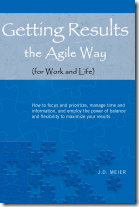Why Agile Results?
My book, Getting Results the Agile Way, puts together patterns, and practices for getting results in work and life. At the heart of the guide, is "Agile Results" -- a simple and flexible system for meaningful results. It supports you and helps you blend your time, energy, and skills for your best results. To put it another way, it helps you “make the most of what you’ve got.”
People ask me, "Why Agile Results?" I've been trying to put my finger on why something so simple works so well ... I think it's the synthesis of:
- Agile - respond to change, story-driven, value-driven, time is a first-class citizen ... etc.
- The Rule of 3 - used from military to marketing for getting results and avoiding overload. See The Rule of 3.
- Lean - Demand driven, avoid getting stuck in the process, reduce open work, hack away at the unessential.
- Scrum - Backlog + sprints to bite off what you can chew.
- Stories - We're wired for stories, making meaning, emotional connection, … etc.
- Positive psychology - Three things going well, focus on forward, … etc.
- Strengths-focus - Spend more time where it matters, focus on energy over time, … etc.
- Project management - Think in terms of projects, have a start and end, know the work, know your capacity and throughput, … etc.
It's a lot compacted into a simple frame
- Use 3 stories - 3 stories for your day, for your week, for your month, for your year, for your life.
- Ride the rhythms of results - Focus on weekly results - Monday vision, daily outcomes, Friday reflection. See Monday Vision, Daily Outcomes, and Friday Reflection.
- Let things go and slough off – This is the art of letting the right things go to spend more time on the right things .
- Catch your next best train ... set the trains to leave the station each day, each week, each month ... miss the train today, catch your next best one over dwell on the train you missed ... get up to bat time and again.
All roads lead to the same town. I was living Agile and Scrum long before they became vogue or I knew what they were. I remember when Peter Provost joined our team years back and he told me I was already doing Agile. I remember some years later when I described my approach to James Waletzky, he said I was doing Scrum.
In both cases, I was glad to have a name for it, but at the same time, I cared more about the underlying principles, patterns, and practices, as well as meaningful intersections. In the bigger picture, I cared even more about how to take proven practices in software engineering and apply them to shape other aspects of life … to lead a life by design, not by default.
